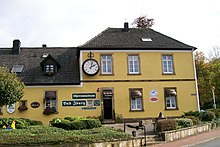Clock Museum Bad Iburg
The clock museum in Bad Iburg (Lower Saxony) is a private museum with more than 800 functional timepieces.
The museum in a building from 1820 opposite the Gografenhof, today's town hall of the city, presents the history of clocks from more than three centuries from the tower clock of the 17th century to the modern radio clock . The museum was founded in 1976 by the merchant and Watch collector Peter Taschenmacher opens.
The oldest exhibit is a French sundial from 1470. The exhibits include 17 tower clocks , including a tower clock from 1688 with spindle escapement , a tower clock from 1723 with scissor escapement, a church tower clock from 1848 with Graham escapement and other tower clocks from the second half of the 19th century up to tower clocks of the 20th century, including those made by Korfhage & Sons from Buer near Melle in the Osnabrück region.
The collection includes around a hundred Black Forest clocks and precious pocket watches as well as skeleton watches . As a curiosity, a French midday cannon sundial from 1800 is shown, which woke up from the midday rest with a loud bang. Other timepieces on display are a candle clock , a speaking clock for the blind and a time clock .
Parking meters that ran for a quarter of an hour for five pfennigs date from the 1970s . The largest radio-controlled pocket watch in the world with a diameter of 1.80 meters and a weight of 150 kilograms was recorded in the Guinness Book of Records . She decorates the facade of the museum.
There are also shops and a café-restaurant in the building.
See also
Web links
- Information about the clock museum on the website of the city of Bad Iburg
- Noon bang woke sleeping aristocrats. In: Berliner Zeitung . October 30, 1999, accessed September 4, 2015 .
Individual evidence
- ↑ Historical and modern tower clocks in the Clock Museum Bad Iburg 1. www.uhrenhanse.de, accessed on August 23, 2017 .
Coordinates: 52 ° 9 ′ 30 ″ N , 8 ° 2 ′ 47 ″ E
